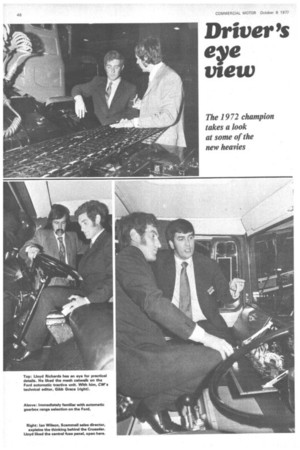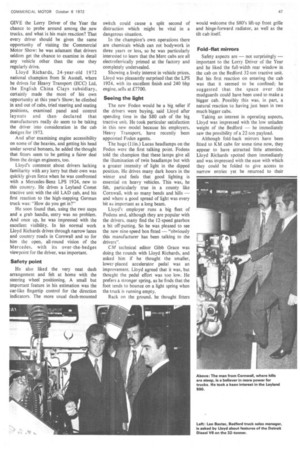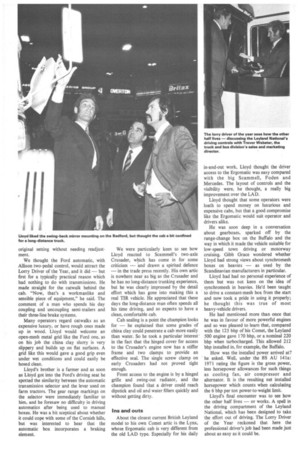Driver's eye view
Page 48

Page 49

Page 50

If you've noticed an error in this article please click here to report it so we can fix it.
GIVE the Lorry Driver of the Year the chance to probe around among the ,new trucks, and what is his main reaction? That every driver should be given the same opportunity of visiting the Commercial Motor Show: he was adamant that drivers seldom get the chance to examine in detail any vehicle other than the one they regularly drive.
Lloyd Richards, 24-year-old 1972 national champion from St Austell, where he drives for Heavy Transport (ECC) Ltd, the English China Clays subsidiary, certainly made the most of his own opportunity at this year's Show; he climbed in and out of cabs, tried steering and seating positions, examined panel and control layouts and then declared that manufacturers really do seem to be taking the driver into consideration in the cab designs for 1973.
And after examining engine accessibility on some of the heavies, and getting his head under several bonnets, he added the thought that fitters seem to be getting a fairer deal from the design engineers, too.
Lloyd's comment about drivers lacking familiarity with any lorry but their own was quickly given force when he was confronted with a Mercedes-Benz LPS 1924, new to this country. He drives a Leyland Comet tractive unit with the old LAD cab, and his first reaction to the high-stepping German truck was: "How do you get in?"
He soon found that, using the two steps and a grab handle, entry was no problem. And once up, he was impressed with the excellent visibility. In his normal work Lloyd Richards drives through narrow lanes and country roads in Cornwall and so for him the open, all-round vision of the Mercedes, with its over-the-hedges viewpoint for the driver, was important.
Safety point He also liked the very neat dash arrangement and felt at home with the steering wheel positioning. A small but important feature in his estimation was the car-like fingertip control for the direction indicators. The more usual dash-mounted switch could cause a split second of distraction which might be vital in a dangerous situation.
In the champion's own operations there are chemicals which can rot bodywork in three years or less, so he was particularly interested to learn that the Merc cabs are all electroferrically primed at the factory and completely undersealed.
Showing a lively interest in vehicle prices, Lloyd was pleasantly surprised that the LPS 1924, with its excellent finish and 240 bhp engine, sells at £7700.
Seeing the light The new Foden would be a big seller if the drivers were buying, said Lloyd after spending time in the 580 cab of the big tractive unit. He took particular satisfaction in this new model because his employers, Heavy Transport, have recently been appointed Foden agents.
The huge (11in.) Lucas headlamps on the Foden were the first talking point. Fodens told the champion that these lamps give all the illumination of twin headlamps but with a greater intensity of light in the dipped position. He drives many dark hours in the winter and feels that good lighting is essential on heavy vehicles. This was, he felt, particularly true in a county like Cornwall, with so many bends and hills — and where a good spread of fight was every bit as important as a long beam.
Lloyd's employer runs a big fleet of Fod ens and, although they are popular with the drivers, many find the 12-speed gearbox a bit off-putting. So he was pleased to see the new nine-speed box fitted — "obviously this manufacturer has been talking to the drivers".
CM technical editor Gibb Grace was doing the rounds with Lloyd Richards, and asked him if he thought the smaller, lower-placed accelerator pedal was an improvement. Lloyd agreed that it was, but thought the pedal effort was too low. He prefers a stronger spring, as he finds that the foot tends to bounce on a light spring when the truck is running empty.
Back on the ground. he thought fitters would welcome the S80's lift-up front grille and hinge-forward radiator, as well as the tilt cab itself.
Fold-flat mirrors Safety aspects are — not surprisingly — important to the Lorry Driver of the Year and he liked the full-width rear window in the cab on the Bedford 32-ton tractive unit. But his first reaction on entering the cab was that it seemed to be confined; he suggested that the space over the mudguards could have been used to make a bigger cab. Possibly this was, in part, a natural reaction to having just been in two much bigger cabs.
Taking an interest in operating aspects, Lloyd was impressed with the low unladen weight of the Bedford — he immediately saw the possibility of a 22-ton payload.
Although fold-back mirrors have been fitted to KM cabs for some time now, they appear to have attracted little attention. Lloyd Richards spotted them immediately and was impressed with the ease with which they could be folded to give access to narrow entries yet be returned to their original setting without needing readjustment.
We thought the Ford automatic, with Allison two-pedal control, would attract the Lorry Driver of the Year, and it did — but first for a typically practical reason which had nothing to do with transmissions. He made straight for the catwalk behind the cab. "Now, that's a workmanlike and sensible piece of equipment," he said. The comment of a man who spends his day coupling and uncoupling semi-trailers and their three-line brake systems.
Many operators regard catwalks as an expensive luxury, or have rough ones made up in wood. Lloyd would welcome an open-mesh metal grid like the Ford one, as on his job the china clay slurry is very slippery and builds up on flat surfaces. A grid like this would gave a good grip even under wet conditions and could easily be hosed clean.
Lloyd's brother is a farmer and as soon as Lloyd got into the Ford's driving seat he spotted the similarity between the automatic transmission selector and the lever used on farm tractors. The gear range markings on the selector were immediately familiar to him, and he foresaw no difficulty in driving automatics after being used to manual boxes. He was a bit sceptical about whether it could cope with some of the Cornish hills, but was interested to hear that the automatic box incorporates a braking element. We were particularly keen to see how Lloyd reacted to Scammell's two-axle Crusader, which has come in for some criticism — and drawn a spirited defence — in the trade press recently. His own artic is nowhere near as big as the Crusader and he has no long-distance trunking experience, but he was clearly impressed by the detail effort which has gone into making this a real TIR vehicle. He appreciated that these days the long-distance man often spends all his time driving, and so expects to have a clean, comfortable cab.
Cab sealing is a point the champion looks for — he explained that some grades of china clay could penetrate a cab more easily than water. So he took a particular interest' in the fact that the hinged cover for access to the Crusader's engine now has a stiffer frame and two clamps to provide an effective seal. The single screw clamp on early Crusaders had not proved tight enough.
Front access to the engine is by a hinged grille and swing-out radiator, and the champion found that a driver could reach dipstick and oil and water fillers quickly and without getting dirty.
Ins and outs
About the closest current British Leyland model to his own Comet artic is the Lynx, whose Ergomatic cab is very different from the old LAD type. Especially for his daily
in-and-out work, Lloyd thought the driver access to the Ergomatic was easy compared with the big Scammell, Foden and Mercedes. The layout of controls and the visibility were, he thought, a really big improvement over the LAD.
Lloyd thought that some operators were loath to spend money on luxurious and expensive cabs, but that a good compromise like the Ergomatic would suit operator and drivers alike.
He was soon deep in a conversation about gearboxes, sparked off by the range-change box on the Buffalo and the way in which it made the vehicle suitable for low-speed town driving or motorway cruising. Gibb Grace wondered whether Lloyd had strong views about synchromesh boxes on heavies — as used by the Scandinavian manufacturers in particular.
Lloyd had had no personal experience of them but was not keen on the idea of synchromesh in heavies. He'd been taught to drive a constant-mesh box from the start and now took a pride in using it properly; he thought this was true of most heavy-vehicle drivers.
He had mentioned more than once that he was in favour of more powerful engines and so was pleased to learn that, compared with the 125 bhp of his Comet, the Leyland 500 engine gave 170 bhp, or a nominal 220 bhp when turbocharged. This allowed 212 bhp installed in, for example, the Buffalo.
How was the installed power arrived at? he asked. Well, under the BS AU 141a: 1971 rating the figure is the gross power, less horsepower allowances for such things as cooling fan, air compressor and alternator. It is the resulting net installed horsepower which counts when calculating the 6 bhp per ton power-to-weight limit.
Lloyd's final encounter was to see how the other half lives — or works. A spell in the driving compartment of the Leyland National, which has been designed to take the effort out of driving. The Lorry Driver of the Year reckoned that here the professional driver's job had been made just about as easy as it could be.






































































































